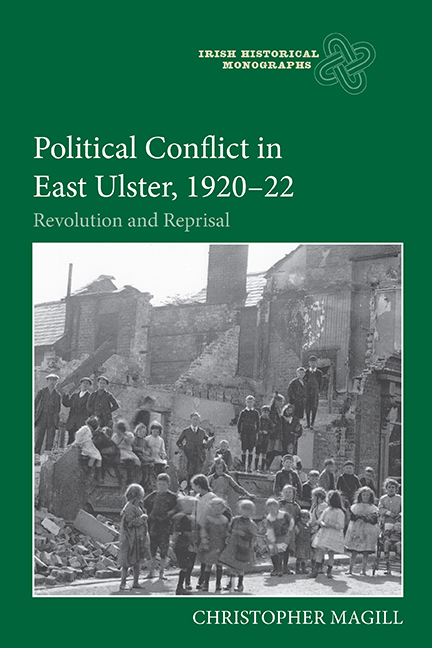Book contents
- Frontmatter
- Dedication
- Contents
- List of Illustrations
- Acknowledgements
- Abbreviations
- A Note on Terminology
- Map
- ‘Cork Justice Travelled a Long Way’: the Assassination of District Inspector Oswald Swanzy
- 1 From Moderates to Militants: the Unionist Community in East Ulster
- 2 Reprisal: the East Ulster Riots
- 3 ‘A Vital But Unenviable Task’: Understanding Loyalist Violence
- 4 A Protestant Force: the Social Composition of the B Specials
- 5 The Wilder the Better? Explaining the Violence of the Ulster Special Constabulary
- 6 A Misunderstood Minority: Irish Nationalists
- Conclusion
- Bibliography
- Index
- Irish Historical Monographs Previous Volumes
2 - Reprisal: the East Ulster Riots
Published online by Cambridge University Press: 21 October 2020
- Frontmatter
- Dedication
- Contents
- List of Illustrations
- Acknowledgements
- Abbreviations
- A Note on Terminology
- Map
- ‘Cork Justice Travelled a Long Way’: the Assassination of District Inspector Oswald Swanzy
- 1 From Moderates to Militants: the Unionist Community in East Ulster
- 2 Reprisal: the East Ulster Riots
- 3 ‘A Vital But Unenviable Task’: Understanding Loyalist Violence
- 4 A Protestant Force: the Social Composition of the B Specials
- 5 The Wilder the Better? Explaining the Violence of the Ulster Special Constabulary
- 6 A Misunderstood Minority: Irish Nationalists
- Conclusion
- Bibliography
- Index
- Irish Historical Monographs Previous Volumes
Summary
I
Between the summer of 1920 and autumn of 1922, the six counties that would become Northern Ireland witnessed intermittent communal violence on a scale comparable to the deadliest periods of the post-1968 Troubles. During this period, approximately 557 people were killed in the six-county area, with most deaths occurring in Belfast. The violence – involving civilians from both sides of the communal divide – generally took the form of rioting, although targeted killings were also commonplace. Involving not only paramilitaries and state forces, but often led by civilians staging street battles in residential areas, this violence differed markedly from patterns in the south where the IRA campaign escalated from the spring of 1920.
It was, in part, a product of deteriorating security conditions in Ulster from 1920. With Crown forces concentrated in southern Ireland, and fewer resources available to deal with escalating disorder in the north-east, loyalists – feeling exposed to potential IRA attacks and fearful of being forced into an Irish republic – responded by attacking Catholic civilians and property. Civilian patrols, ostensibly to restore order, but also to protect against the threat of republican violence, were also established. This occurred not only in Belfast, where most historiographical interest has focused, but also across the towns of east Ulster. In Banbridge, Dromore, Lisburn and Newtownards, riots in the summer of 1920 were followed by civilian initiatives designed to fill the perceived security void. These developments led directly to unionist leaders pressuring the British government to establish the USC in late 1920.
To fully understand events in Belfast, and the circumstances in which Northern Ireland was established, a greater appreciation of developments in east Ulster is required. Communal violence in Banbridge and Lisburn foreshadowed, and contributed to, the escalating violence in Belfast. Expulsions from Belfast's shipyards where Catholic workers were intimidated from their jobs in an incident often seen as the trigger for wider communal violence in that city occurred on the same day as the funeral in Banbridge of RIC Divisional Commissioner Gerald B. Smyth, who had been recently gunned down by the IRA in Cork. The expulsions were the culmination of several factors, but the death of a senior police officer from east Ulster at the hands of the IRA was central. Similarly, in August, violence again erupted in Belfast after District Inspector Oswald Swanzy was shot dead in Lisburn.
- Type
- Chapter
- Information
- Political Conflict in East Ulster, 1920–22Revolution and Reprisal, pp. 39 - 62Publisher: Boydell & BrewerPrint publication year: 2020

